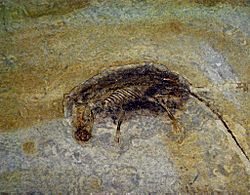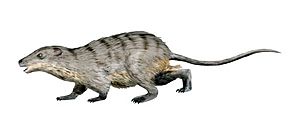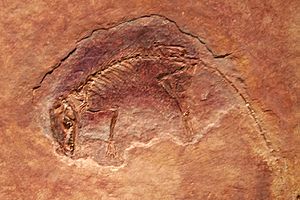Eomaia facts for kids
Quick facts for kids EomaiaTemporal range: Lower Cretaceous, 125 mya
|
|
|---|---|
 |
|
| Eomaia | |
| Scientific classification | |
| Kingdom: | |
| Phylum: | |
| Class: | |
| Subclass: | |
| Infraclass: | |
| Genus: |
Eomaia
Ji et al., 2002
|
| Species | |
|
|
Eomaia (which means 'dawn mother') is a very old fossil mammal. It's special because it's incredibly well-preserved, even though it lived 125 million years ago! This ancient creature helps scientists understand how early mammals developed.
Contents
Discovery and Appearance
Eomaia was found in rocks from the Yixian Formation in Liaoning Province, China. These rocks are about 125 million years old, from a time called the Lower Cretaceous period.
The fossil is about 10 centimetres (3.9 in) long, which is quite small. It probably weighed around 20–25 grams (0.71–0.88 oz), like a small mouse. Even though its skull is flat, you can still see its tiny teeth, foot bones, and even traces of its fur!
Eomaia and Mammal Family Tree
Eomaia is known as a eutherian. Eutherians are a group of mammals that includes all modern placental mammals (like humans, dogs, and elephants) and some extinct mammals that were closely related but didn't have a full placenta.
What makes eutherians different from metatherians (the group that includes modern marsupials like kangaroos) are certain features in their feet, jaws, and teeth.
Why Eomaia is Special
Even though Eomaia is a eutherian, it's not considered a "true" placental mammal. This is because it lacks some features that are only found in placental mammals. For example:
- Its shin and ankle bones are a bit different from modern placental mammals.
- It has an older type of dental formula (the arrangement of teeth).
- It has a wide opening at the bottom of its pelvis. This wide opening would allow for the birth of larger, more developed babies. Marsupials and other non-placental eutherians have a narrower opening, meaning they give birth to very small, less developed offspring.
- Eomaia also has special bones called epipubic bones that stick out from its pelvis. These bones are not found in any placental mammals today. However, they are found in almost all other mammals, and even in older mammal-like reptiles. These bones help stiffen the body when moving. In pregnant placental mammals, this stiffness would be a problem because their bellies need to expand.
Scientists studied many features of Eomaia and compared them to other ancient mammals. They believe Eomaia is very close to the very beginning of the eutherian "family tree," along with a few other early fossils.
The Eomaia fossil clearly shows traces of hair. However, this isn't the oldest proof of hair in mammals. Fossils of another ancient mammal called Castorocauda, found in rocks about 164 million years old, also show traces of fur.
Related ancient mammals
Images for kids
See also
 In Spanish: Eomaia para niños
In Spanish: Eomaia para niños





